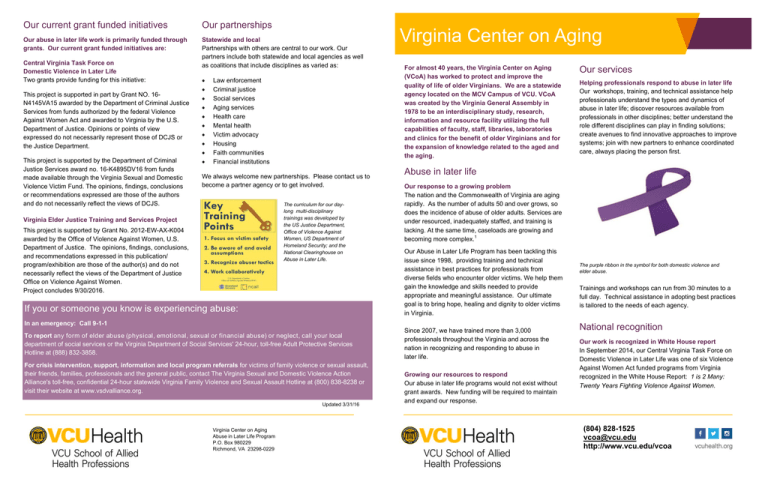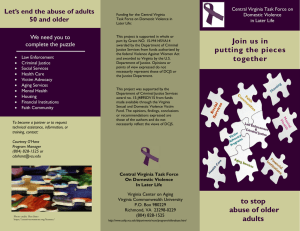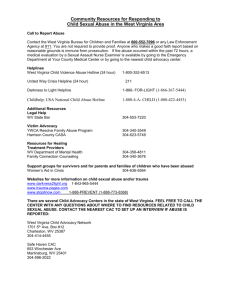
Our current grant funded initiatives
Our partnerships
Our abuse in later life work is primarily funded through
grants. Our current grant funded initiatives are:
Statewide and local
Partnerships with others are central to our work. Our
partners include both statewide and local agencies as well
as coalitions that include disciplines as varied as:
Central Virginia Task Force on
Domestic Violence in Later Life
Two grants provide funding for this initiative:
This project is supported in part by Grant NO. 16N4145VA15 awarded by the Department of Criminal Justice
Services from funds authorized by the federal Violence
Against Women Act and awarded to Virginia by the U.S.
Department of Justice. Opinions or points of view
expressed do not necessarily represent those of DCJS or
the Justice Department.
This project is supported by the Department of Criminal
Justice Services award no. 16-K4895DV16 from funds
made available through the Virginia Sexual and Domestic
Violence Victim Fund. The opinions, findings, conclusions
or recommendations expressed are those of the authors
and do not necessarily reflect the views of DCJS.
Law enforcement
Criminal justice
Social services
Aging services
Health care
Mental health
Victim advocacy
Housing
Faith communities
Financial institutions
We always welcome new partnerships. Please contact us to
become a partner agency or to get involved.
The curriculum for our daylong multi-disciplinary
trainings was developed by
the US Justice Department,
Office of Violence Against
Women, US Department of
Homeland Security; and the
National Clearinghouse on
Abuse in Later Life.
Virginia Elder Justice Training and Services Project
This project is supported by Grant No. 2012-EW-AX-K004
awarded by the Office of Violence Against Women, U.S.
Department of Justice. The opinions, findings, conclusions,
and recommendations expressed in this publication/
program/exhibition are those of the author(s) and do not
necessarily reflect the views of the Department of Justice
Office on Violence Against Women.
Project concludes 9/30/2016.
If you or someone you know is experiencing abuse:
Virginia Center on Aging
For almost 40 years, the Virginia Center on Aging
(VCoA) has worked to protect and improve the
quality of life of older Virginians. We are a statewide
agency located on the MCV Campus of VCU. VCoA
was created by the Virginia General Assembly in
1978 to be an interdisciplinary study, research,
information and resource facility utilizing the full
capabilities of faculty, staff, libraries, laboratories
and clinics for the benefit of older Virginians and for
the expansion of knowledge related to the aged and
the aging.
For crisis intervention, support, information and local program referrals for victims of family violence or sexual assault,
their friends, families, professionals and the general public, contact The Virginia Sexual and Domestic Violence Action
Alliance's toll-free, confidential 24-hour statewide Virginia Family Violence and Sexual Assault Hotline at (800) 838-8238 or
visit their website at www.vsdvalliance.org.
Updated 3/31/16
Helping professionals respond to abuse in later life
Our workshops, training, and technical assistance help
professionals understand the types and dynamics of
abuse in later life; discover resources available from
professionals in other disciplines; better understand the
role different disciplines can play in finding solutions;
create avenues to find innovative approaches to improve
systems; join with new partners to enhance coordinated
care, always placing the person first.
Abuse in later life
Our response to a growing problem
The nation and the Commonwealth of Virginia are aging
rapidly. As the number of adults 50 and over grows, so
does the incidence of abuse of older adults. Services are
under resourced, inadequately staffed, and training is
lacking. At the same time, caseloads are growing and
becoming more complex.1
Our Abuse in Later Life Program has been tackling this
issue since 1998, providing training and technical
assistance in best practices for professionals from
diverse fields who encounter older victims. We help them
gain the knowledge and skills needed to provide
appropriate and meaningful assistance. Our ultimate
goal is to bring hope, healing and dignity to older victims
in Virginia.
In an emergency: Call 9-1-1
To report any form of elder abuse (physical, emotional, sexual or financial abuse) or neglect, call your local
department of social services or the Virginia Department of Social Services' 24-hour, toll-free Adult Protective Services
Hotline at (888) 832-3858.
Our services
Since 2007, we have trained more than 3,000
professionals throughout the Virginia and across the
nation in recognizing and responding to abuse in
later life.
Growing our resources to respond
Our abuse in later life programs would not exist without
grant awards. New funding will be required to maintain
and expand our response.
The purple ribbon in the symbol for both domestic violence and
elder abuse.
Trainings and workshops can run from 30 minutes to a
full day. Technical assistance in adopting best practices
is tailored to the needs of each agency.
National recognition
Our work is recognized in White House report
In September 2014, our Central Virginia Task Force on
Domestic Violence in Later Life was one of six Violence
Against Women Act funded programs from Virginia
recognized in the White House Report: 1 is 2 Many:
Twenty Years Fighting Violence Against Women.
Virginia Center on Aging
Abuse in Later Life Program
P.O. Box 980229
Richmond, VA 23298-0229
(804) 828-1525
vcoa@vcu.edu
http://www.vcu.edu/vcoa
Abuse in Later Life Program
The numbers
Questions and answers
Aging of the population
Every day in the US, 10,000 people turn 65.2 The
fastest growing demographic is those over 80.3
Who is affected by abuse in later life?
People from all backgrounds:
all income levels
all ages from 50 to 100+
all racial and ethnic groups
all religions
all living settings
women and men
all geographic settings
all ability levels
Underreporting of abuse
Elder abuse can be difficult to research, since most
cases go unreported. One study estimated four out of
five cases go unreported and another suggests
unreported cases are 24 times those of reported cases.4
Many studies, however, don’t reveal the full scope of the
problem because they limited the types of abuse
explored or they excluded older adults with
cognitive impairments.
Health and economic costs
Current data suggest about ten percent of people 60 and
older who live at home suffer abuse, neglect
or exploitation.5
Some studies show approximately half of those with
dementia are victims of abuse, neglect or exploitation.6
Abuse in later life triples the risk of premature death and
causes unnecessary illness, injury and suffering.7 Victims
are four times more likely to be admitted to a nursing
home and three times more likely to be admitted to
a hospital.18
While not much research has been done on the total
economic cost, one study found the annual financial loss
by victims nationwide was estimated to be at least $2.9
billion in 2010, an increase of 12% over 2008.9
Those with cognitive incapacities suffer 100%
greater economic losses than those without
cognitive incapacities.10
What does it look like?
Abusive behavior includes:
controlling who the victims see, what they do, where they
go, or what happens with their money
calling the victims names or threatening to hurt them
stealing from the victims
threatening to leave or put them in a nursing home
hurting the victims’ pets
hitting, shaking, pushing, burning or choking the victims
touching the victims in ways or places they do not want to
be touched
withholding food, water, medication or other needed
goods or services
What are the signs an older adult may have
been victimized?
A victim of abuse in later life may have any of the
following signs:
fear
unexplained injuries
isolation or withdrawal
verbal abuse or controlling behavior by a caregiver or
family member
lack of amenities or medical aids he or she should be able
to afford
loss of control of funds
unexplained sexually transmitted disease
Sources:
1. Government Accountability Office (2011). Stronger federal leadership could enhance national response to elder abuse. Retrieved from http://
www.gao.gov/assets/320/316224.pdf U. S. , “What GAO Found.”
2. Pew Research Center at http://www.pewresearch.org/daily-number/baby-boomers-retire/
3. U. S. Census Bureau at http://www.census.gov/prod/cen2010/briefs/c2010br-03.pdf
4. Virginia Department for Aging and Rehabilitative Services (2014). Strategies to Improve the Safety, Financial Stability, and Well-being of Adults with
Disabilities and Older Adults throughout the Commonwealth http://www.dss.virginia.gov/files/division/dfs/as/aps/intro_page/prevention_month/
activities_resources/DARS_Report_on_Adult_Abuse.pdf, p. 8
What are people saying about our trainings?
When asked, “What did you like” and “What was
most valuable,” participants in our cross-training
for victim service providers responded:
[information on] ageism; makes you
more aware
not [making assumptions] about people
learning about all the agencies that can assist
the different approaches by different agencies
use of videos in increasing sensitivity to different
aspects of [abuse]
trainers were experienced and gave good
examples from their work
safety plans ...[and] questions to ask victims
information on abuser tactics
engagement…kept me interested and involved
different ... way of thinking; areas to improve on
best activities in any training I’ve had
now [I] know how to handle these referrals/issues
in my clients
learning to collaborate more with other agencies
and services
Comment from a trainer on the nationally developed
day-long victim services curriculum
The time, planning, and detail that has been put into this
curriculum almost makes the process seem
effortless ... Every detail has been covered. Power
Points, sample scripts, videos, and even small group
discussions have been planned out to the minute. We
have everything we need to facilitate Abuse in Later Life
workshops for victim and aging service practitioners ...
When asked, “What did you like” and “What was
most valuable,” participants in our law
enforcement training responded:
first class attended in 18 years that addressed this
issue. Very good.
explanation of elder abuse statutes
the emphasis on agency collaboration
being reminded that elder abuse occurs more
often than we think
real life examples
the details to look for to initiate a case
learning about the [long-term care] ombudsman
learning about APS
really wonderful job!! All of the trainers presented
as if they had been doing this together for years!!!
great job in talking about cognitive limitations, how
this impacts the investigation
good information regarding conducting interviews
and possible roadblocks
helping recognize abuse signs and how to
start investigations.
gaining more information and resources to better
investigate these incidents
Comment on a cross-disciplinary training for a
project kick-off
Judges joined with social workers and law enforcement
officers joined with attorneys, mental health professionals
joined with the faith community leaders and bankers joined
with prosecutors; . . . Each member brought to the table
their expertise and knowledge, and each … left the table
with more of both ...
5. Lifespan of Greater Rochester, Inc., Weill Cornell Medical Center of Cornell University, & New York City Department for the Aging. (2011). Under the
Radar: New York State Elder Abuse Prevalence Study. Self-reported prevalence and documented case surveys [Final Report]. 2014, from http://
www.lifespan-roch.org/documents/UndertheRadar051211.pdf; and Acierno, R., Hernandez, M. A., Amstadter, A. B., Resnick, H. S., Steve, K.,
Muzzy, W., & Kilpatrick, D. J. (2010). Prevalence and correlates of emotional, physical, sexual, and financial abuse and potential neglect in the
United States: The National Elder Mistreatment Study. American Journal of Public Health, 100(2), 292-297.
6. Wiglesworth, A., Mosqueda, L., Mulnard, R., Liao, S., Gibbs, L., & Fitzgerald, W. (2010). Screening for abuse and neglect of people with dementia.
Journal of the American Geriatrics Society, 58(3), 493-500; and Cooney, C., Howard, R., & Lawlor, B. (2006). Abuse of vulnerable people with
dementia by their carers: Can we identify those most at risk? International Journal of Geriatric Psychiatry, 21(6), 564-571; and Cooper, C., Selwood,
A., Blanchard, M., Walker, Z., Blizard, R., & Livingston, G. (2009). Abuse of people with dementia by family caregivers: Representative cross
, 338, b155.
sectional survey.
7. Lachs, M. S., Williams, C. S., O’Brien, S., Pillemer, K.A., & Charlson, M. E. (1998). The mortality of elder mistreatment. Journal of the American
Medical Association, 280(5), 428-432. (p. 431).
, 173 (10), 911-917.
8. Dong, X. Q., & Simon, M. A. (2013). Elder abuse as a risk factor for hospitalization in older persons.
9 . The MetLife Study of Elder Financial Abuse (2011) http://www.preventelderabuse.org/documents/mmi-elder-financial-abuse.pdf
10. Gunther, J. (2011). The Utah cost of financial exploitation. Salt Lake City, UT: Utah Division of Aging and Adult Services. Retrieved March 12, 2014,
.pdf. Gunther, J. (2012). The 2010 Utah Cost of Financial Exploitation. Salt Lake City,
from www
UT: Utah Division of Aging and Adult Services.
Our current grant funded initiatives
Our partnerships
Our abuse in later life work is primarily funded through
grants. Our current grant funded initiatives are:
Statewide and local
Partnerships with others are central to our work. Our
partners include both statewide and local agencies as well
as coalitions that include disciplines as varied as:
Central Virginia Task Force on
Domestic Violence in Later Life
Two grants provide funding for this initiative:
This project is supported in part by Grant NO. 16N4145VA15 awarded by the Department of Criminal Justice
Services from funds authorized by the federal Violence
Against Women Act and awarded to Virginia by the U.S.
Department of Justice. Opinions or points of view
expressed do not necessarily represent those of DCJS or
the Justice Department.
This project is supported by the Department of Criminal
Justice Services award no. 16-K4895DV16 from funds
made available through the Virginia Sexual and Domestic
Violence Victim Fund. The opinions, findings, conclusions
or recommendations expressed are those of the authors
and do not necessarily reflect the views of DCJS.
Law enforcement
Criminal justice
Social services
Aging services
Health care
Mental health
Victim advocacy
Housing
Faith communities
Financial institutions
We always welcome new partnerships. Please contact us to
become a partner agency or to get involved.
The curriculum for our daylong multi-disciplinary
trainings was developed by
the US Justice Department,
Office of Violence Against
Women, US Department of
Homeland Security; and the
National Clearinghouse on
Abuse in Later Life.
Virginia Elder Justice Training and Services Project
This project is supported by Grant No. 2012-EW-AX-K004
awarded by the Office of Violence Against Women, U.S.
Department of Justice. The opinions, findings, conclusions,
and recommendations expressed in this publication/
program/exhibition are those of the author(s) and do not
necessarily reflect the views of the Department of Justice
Office on Violence Against Women.
Project concludes 9/30/2016.
If you or someone you know is experiencing abuse:
Virginia Center on Aging
For almost 40 years, the Virginia Center on Aging
(VCoA) has worked to protect and improve the
quality of life of older Virginians. We are a statewide
agency located on the MCV Campus of VCU. VCoA
was created by the Virginia General Assembly in
1978 to be an interdisciplinary study, research,
information and resource facility utilizing the full
capabilities of faculty, staff, libraries, laboratories
and clinics for the benefit of older Virginians and for
the expansion of knowledge related to the aged and
the aging.
For crisis intervention, support, information and local program referrals for victims of family violence or sexual assault,
their friends, families, professionals and the general public, contact The Virginia Sexual and Domestic Violence Action
Alliance's toll-free, confidential 24-hour statewide Virginia Family Violence and Sexual Assault Hotline at (800) 838-8238 or
visit their website at www.vsdvalliance.org.
Updated 3/31/16
Helping professionals respond to abuse in later life
Our workshops, training, and technical assistance help
professionals understand the types and dynamics of
abuse in later life; discover resources available from
professionals in other disciplines; better understand the
role different disciplines can play in finding solutions;
create avenues to find innovative approaches to improve
systems; join with new partners to enhance coordinated
care, always placing the person first.
Abuse in later life
Our response to a growing problem
The nation and the Commonwealth of Virginia are aging
rapidly. As the number of adults 50 and over grows, so
does the incidence of abuse of older adults. Services are
under resourced, inadequately staffed, and training is
lacking. At the same time, caseloads are growing and
becoming more complex.1
Our Abuse in Later Life Program has been tackling this
issue since 1998, providing training and technical
assistance in best practices for professionals from
diverse fields who encounter older victims. We help them
gain the knowledge and skills needed to provide
appropriate and meaningful assistance. Our ultimate
goal is to bring hope, healing and dignity to older victims
in Virginia.
In an emergency: Call 9-1-1
To report any form of elder abuse (physical, emotional, sexual or financial abuse) or neglect, call your local
department of social services or the Virginia Department of Social Services' 24-hour, toll-free Adult Protective Services
Hotline at (888) 832-3858.
Our services
Since 2007, we have trained more than 3,000
professionals throughout the Virginia and across the
nation in recognizing and responding to abuse in
later life.
Growing our resources to respond
Our abuse in later life programs would not exist without
grant awards. New funding will be required to maintain
and expand our response.
The purple ribbon in the symbol for both domestic violence and
elder abuse.
Trainings and workshops can run from 30 minutes to a
full day. Technical assistance in adopting best practices
is tailored to the needs of each agency.
National recognition
Our work is recognized in White House report
In September 2014, our Central Virginia Task Force on
Domestic Violence in Later Life was one of six Violence
Against Women Act funded programs from Virginia
recognized in the White House Report: 1 is 2 Many:
Twenty Years Fighting Violence Against Women.
Virginia Center on Aging
Abuse in Later Life Program
P.O. Box 980229
Richmond, VA 23298-0229
(804) 828-1525
vcoa@vcu.edu
http://www.vcu.edu/vcoa







